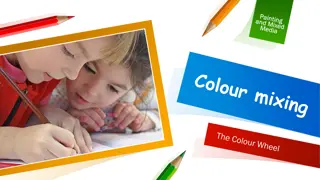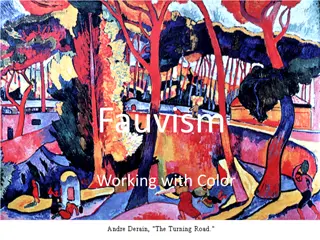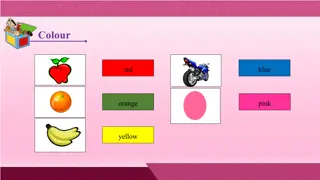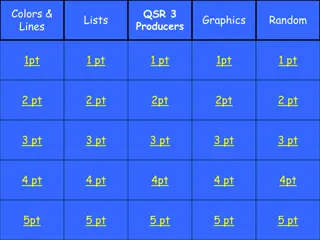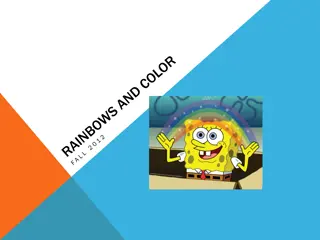Color Theory: A Comprehensive Guide to Colors
Explore the fascinating world of colors with an in-depth look into color theory. Learn about chromatic and achromatic colors, neutral colors, hues, color wheels, primary and secondary colors, tertiary colors, values, tints, shades, and tones. Delve into the visual responses of the eye to reflected r
2 views • 19 slides
DUKESHIFT VS SECONDARY
DukeShift allows managers to post open shifts for eligible and qualified staff, offering extra shifts filled either by float pool staff or preassigned secondary employees. Secondary hiring managers may opt not to use DukeShift due to various reasons, such as hiring PRNs, tracking time on secondary t
0 views • 19 slides
Enhancing Secondary Channel Usage in IEEE 802.11 Standards
This document, IEEE 802.11-23/1935r1, delves into the intricacies of secondary channel usage within the context of IEEE 802.11 standards. Key topics covered include discussions on RU index, BW negotiation in secondary channels, methods to ensure medium synchronization when transitioning back to prim
1 views • 14 slides
The Basics of Color Theory
A color wheel organizes colors into primary, secondary, and tertiary categories. Primary colors are red, blue, and yellow; secondary colors are green, violet, and orange; and tertiary colors are mixtures of primary and secondary colors. The value of a color refers to how light or dark it is, with ti
4 views • 10 slides
Fun Art Task: Creating a Color Wheel
Explore color relationships by mixing secondary and tertiary colors to create a vibrant color wheel. Learn about primary, secondary, and tertiary colors, and follow step-by-step instructions to create your own color wheel using basic art supplies. Enhance your understanding of color theory through t
1 views • 12 slides
The Role of Secondary Eye Care in Relation to Primary Eye Care
Secondary eye care services, located in hospital settings, play a crucial role in providing specialized diagnostics, treatment, and rehabilitation to a large population. They serve as the first contact point for specialist services, contributing to successful referral pathways and collaborative part
0 views • 5 slides
Light and Lenses: Exploring Colors and Images Formed
Explore the fascinating world of light and lenses in this module. Discover how lenses work, types of lenses like convex and concave, images formed by lenses, and the dispersion of sunlight into seven colors. Engage in activities showcasing the colors of sunlight and delve into the enchanting realm o
2 views • 10 slides
Secondary Growth in Plants: Boerhaavia (Dicot) vs. Dracaena (Monocot)
Secondary growth, resulting from cambial cell division, thickens stems and roots in plants. This process involves cambium, a tissue layer between xylem and phloem, responsible for secondary growth. Cambium ray initials give rise to vascular rays and secondary xylem/phloem. The seasonal activity of c
0 views • 24 slides
Fauvism: Working with Colors and Color Schemes
Fauvism is an art movement known for its bold and arbitrary use of colors. Fauvist painters carefully selected colors to convey specific moods in their artworks. This guide explores Fauvism, color theory, and different color schemes to help you create your own expressive painting. Learn about comple
0 views • 8 slides
Crystal Field Theory and Color Exhibited by Coordination Compounds
Crystal Field Theory (CFT) explains the colors exhibited by coordination compounds based on the absorption of light and electron transitions in d-orbitals. The theory describes how ligands interact with transition metal ions, causing the d-orbitals to split in energy levels. This split results in th
0 views • 30 slides
Supporting Students' Success in Secondary School
Parents play a crucial role in shaping students' experiences in secondary school. By providing support, encouragement, and fostering a positive attitude, students can navigate the challenges of secondary school with confidence. The transition to secondary school can be daunting, but with the right g
0 views • 29 slides
True Colors: A Guide to Personalities in Student Organizations
Explore the concept of True Colors to better understand personalities within student organizations. From discussing group traits to identifying primary colors, this guide offers insights into improving communication and collaboration among members. Discover how self-awareness activities can enhance
0 views • 22 slides
UConn Pre-Med/Dental Secondary Applications Process
Explore the details of secondary applications presented by the UConn Pre-Medical/Dental Center, covering topics such as what secondary applications entail, submission processes, timelines, common questions, and tips/resources. Learn the importance of secondary applications in differentiating yoursel
0 views • 24 slides
True Colors Personality Types and Group Dynamics
Explore the True Colors personality assessment, which categorizes individuals into four distinctive types based on their innate and learned traits. Participants rank categories to reveal their dominant colors - Orange, Gold, Blue, or Green. Groups are formed based on color profiles, each with specif
0 views • 11 slides
Unveiling the Risks of Food Additives and Artificial Colors in Nutrition
Exploring the impact of food additives and artificial colors on nutrition, this content sheds light on the risks associated with their consumption. From artificial colors like Red 40 and Yellow 6 to the behavioral implications in susceptible children, the data presented unveils the potential adverse
1 views • 29 slides
Creating Eye-Catching Poster Designs with Customizable Colors and Formats
Learn how to design visually appealing posters with customizable colors and formats. This guide provides insights into adjusting colors, optimizing layouts for print, and utilizing the zoom slider for detailed examination. Explore examples showcasing effective poster appearance formatting techniques
0 views • 7 slides
Learning Colors in Pennsylvania Dutch: Video Lessons and Practice Questions
Explore the vibrant world of colors in Pennsylvania Dutch through video lessons and practice questions. Learn essential color vocabulary and usage in sentences. Practice identifying colors with everyday objects and scenarios. Get ready to enhance your language skills and engage in immersive learning
0 views • 5 slides
Fun Mitten Colors Song for Kids
Join in on the fun with the Mitten Colors Song! This interactive song encourages kids to clap, stomp, shake, bend, and tap based on the color of their mittens. With catchy lyrics and colorful visuals, children will have a blast while learning colors and movements. Get ready to sing and dance along t
0 views • 11 slides
Spanish 1: Learning Adjectives and Colors
In this Spanish 1 course, students will learn about adjectives and colors to describe nouns in both gender and number forms. The lessons cover the identification of colors, recognizing the correct position, gender, and number of adjectives, as well as identifying objects based on spoken descriptions
0 views • 16 slides
Proposal for Improved Channel Access Efficiency in IEEE 802.11 Networks
The proposal addresses the inefficiencies in utilizing secondary channels in IEEE 802.11 networks, aiming to enhance access to wideband channels (>20 MHz) when the primary channel is busy. It introduces a mechanism for APs and STAs to access available secondary channels while the primary channel is
1 views • 7 slides
RNA Secondary Structure Prediction in Bioinformatics
RNA secondary structure prediction is a key concept in bioinformatics, encompassing features like stems, loops, and bulges. This presentation delves into the importance of RNA beyond mRNA, highlighting rRNA, tRNA, and regulatory RNA roles. The canonical base pairs A-U and C-G shape the single-strand
0 views • 20 slides
Color Blindness: Causes, Symptoms, and Types
Color blindness, also known as color vision deficiency, is a genetic disorder that affects the ability to distinguish between certain colors. It is caused by the absence of color-sensitive pigment in cone cells of the retina, often passed down on the X chromosome. Symptoms vary from difficulty diffe
2 views • 16 slides
Discover a Fun Collection of Swap Cards: Colors, Numbers, and Drinks Preferences
Dive into the world of swap cards featuring various themes such as colors, numbers, and favorite drinks. Explore the vibrant images showcasing different aspects of the swap card collection, from colorful designs to numerical patterns. Uncover the excitement of swapping cards with friends and sharing
0 views • 4 slides
Colorful Images: A Vibrant Collection of Various Colors
Explore a delightful array of colors through captivating images depicting shades of red, blue, orange, pink, yellow, green, black, brown, white, and purple. Engage in a fun exercise to identify the colors of everyday objects and enhance your color recognition skills. The images showcase a diverse ra
0 views • 6 slides
Overview of the Czech Education System: Levels, Structure & Details
The Czech education system comprises pre-school, primary, secondary, and higher secondary levels. Pre-school education includes nursery and kindergarten, primary education focuses on foundational skills and knowledge, secondary education covers a broader range of subjects, and higher secondary offer
1 views • 16 slides
Protein Secondary Structure Prediction: Insights and Methods
Accurate prediction of protein secondary structure is crucial for understanding tertiary structure, predicting protein function, and classification. This prediction involves identifying key elements like alpha helices, beta sheets, turns, and loops. Various methods such as manual assignment by cryst
0 views • 30 slides
Learning Colors, Lines, and Hex Codes for Design
Explore the world of colors, lines, producers, lists, graphics, and hexadecimal codes in this informative image-based content. Learn about hex codes, HTML tags for changing background and text colors, creating lists, and more. Test your knowledge with interactive examples and visuals that demonstrat
0 views • 51 slides
Liability in Negligence for Psychiatric Injury: Primary and Secondary Victims
Psychiatric damage resulting from negligence involves injury to the mind rather than the body, requiring claimants to prove recognized psychiatric injury with medical evidence. Primary victims suffer physical or foreseeable physical and psychiatric injuries, while secondary victims experience psychi
0 views • 23 slides
Colors of the Rainbow Through Hands-On Activities
Engage students in an interactive lesson about rainbows, colors, and light by introducing them to the concept through real-world examples. From observing rainbows in various settings to hands-on experiments creating color wheels, this session aims to deepen understanding of the science behind the vi
0 views • 6 slides
Importance of Color in Design: Warm vs. Cool Colors
Color plays a crucial role in design, with warm colors like red and orange exuding warmth and energy while cool colors like blues and greens convey calmness. Understanding the psychological effects of colors can help in creating the right ambiance for different spaces. Warm colors are ideal for high
0 views • 61 slides
Color Blindness: Causes, Symptoms, and Diagnosis
Color blindness, also known as color vision deficiency, is a genetic disorder that affects the ability to distinguish between colors. John Dalton discovered color blindness in 1794. It is inherited in an X-linked recessive pattern and can cause difficulties in daily life, such as trouble seeing colo
0 views • 13 slides
Spanish Colors Vocabulary and Practice for October
Explore essential Spanish vocabulary related to colors, phrases, nouns, and adjectives for the first part of October. Encourage learning and memorization through interactive websites and engaging phrases. Practice pronunciation and engage in online activities to enhance comprehension. Prepare for a
0 views • 5 slides
Spanish Colors and Phrases Learning Resources for Kids
Explore fun websites and phrases to learn Spanish colors with your child in preparation for an upcoming quiz. Practice pronunciation and memorization using engaging online resources and study tips. The quiz will test oral knowledge of colors and phrases, making learning enjoyable and interactive.
0 views • 5 slides
Overview of Education System in Slovakia
The education system in Slovakia comprises state schools, church-owned schools, and private schools. It includes different school types such as kindergartens, primary schools, secondary schools, and universities. Primary education is free and compulsory, starting at age 6 and divided into two stages
0 views • 11 slides
The Vibrant World of Colors in Poetry and Art
Explore the enchanting relationship between colors, poetry, and art, where painting eloquently speaks in silence and each color vibrates with unique sensations. Dive into the intriguing connections of colors with human senses, emotions, and meanings, unveiling a symphony of visual chords and symphon
0 views • 18 slides
Overview of Color Models in Computer Graphics
Color models in computer graphics play a crucial role in creating a wide range of colors using a limited set of primary colors. There are two main types of color models - additive and subtractive, with RGB being common for displays and CMYK for printing. RGB is additive, combining red, green, and bl
0 views • 16 slides
Mastering CSS Styles for Adding Colors to Your Web Design
Learn how to create custom styles for HTML tags using CSS, including adding colors and defining styles for paragraphs, headings, and table cells. Explore predefined color options and discover how to specify colors using RGB and hex codes for more precise design control. Take away essential tips for
0 views • 6 slides
Color Theory: Basics and Applications
Color theory encompasses the color wheel, color harmony, and how colors are used. It provides a logical structure for organizing and creating colors. Primary, secondary, and tertiary colors play key roles in this theory, along with concepts like color harmony and context. By understanding color theo
0 views • 28 slides
Colors in Mandarin and Chinese Cultural Symbolism
Colors play a significant role in Mandarin language and Chinese culture. This content delves into different colors in Mandarin, such as red symbolizing luck and happiness in Chinese culture. It also explores the cultural significance of other colors like yellow, green, blue, white, and black. Additi
0 views • 9 slides
Information Session on Secondary V Mathematics Program
Providing an overview of the Cultural, Social, and Technical (CST) option in the Secondary V Mathematics Program, this session covers objectives, context, objectives of the meeting, goals of the update, and points to consider. It discusses the process leading to the update, the balance between Secon
0 views • 32 slides



